Miranda Moll
Where do you live: Calgary, Canada
Your education: Bachelor of Science – Honours in Biology; Master of Science – Biodiversity, Wildlife and Ecosystem Health; Doctor of Philosophy – Geoscience and Biological Sciences (currently a student)
Describe your art in three words: Contemplative. Existence. Movement.
Your discipline: Painting and Drawing
Website | Instagram
You have a background in biological sciences and geoscience. How do these fields influence your artistic process and themes?
I have had a deep interest in animals and the biological world for much of my life, long before my entry into a post-secondary classroom. My childhood memories are filled with days exploring the outdoors, hunting for “creepy crawlies,” and desiring to be immersed in the wild. I always felt this strong connection to the natural world and a desire to understand how life functions at its foundational levels.
After entering the post-secondary science world, I had this profound realization of how interconnected everything is. The notion of myself as separate from my surroundings feels incorrect to me at this point in my life. To many, I am viewed as a human, a separate entity from the environment. From some perspectives, this is correct. For example, my consciousness and awareness are centred in my being. I cannot know directly what those around me are experiencing or feeling; I cannot experience or feel as they.
Yet, from my perspective, I am intimately connected to and interwoven with everything around me. My body is supported by trillions and trillions of microorganisms—if they are necessary for my survival, how separate are we? The elements that make up my being are in perpetual flux with the environment, incorporating into my body transiently before passing on to another form. To me, the boundaries between “self” and “environment” or “other” dissolve; it seems an illusion. This deep sense of connection that I have felt for much of my life is validated through science, in my eyes.
During my schooling, I also reflect on how we, as humans, categorize and describe the natural world. Our biological definitions and constructs—abiotic and biotic, kingdoms and species, and the hierarchies amongst the natural world—are unavoidably shaped by our perspective and what we can understand at any point in time. These categories and definitions are dynamic, shifting with each scientific advancement and what can be directly measured or observed. It makes me acutely aware that there is a whole world we do not understand, because we cannot see and measure it presently.
We once viewed humans as the epitome of life on our planet, and as animals being significantly less intelligent and conscious as compared to ourselves. Forget about other lifeforms like plants, fungi, or bacteria. Yet year after year, we have breakthrough discoveries showcasing the intelligence and amazing capabilities of our fellow species, some of which are far superior to our own. These discoveries are not limited to the animal world; plants and fungi, too, have revealed astonishing capabilities that shake the foundations of the scientific world we built. Our understanding at present shows that at the cellular level, the same processes and principles are present in virtually all life we can observe. Small differences occur and lead eventually to evolutionary changes and speciation, but we are all governed by the same forces.
When I am exploring nature and am deeply present in the moment—a phenomenon that does not always happen in the chaos of everyday life—I can be struck by a thought. Seeing a tree or an insect, and truly seeing this other lifeform, I think how interesting it is that we are two beings experiencing the same moment in time from different perspectives. That we have evolved separately, but in tandem, for millions or possibly billions of years, diverging from our most recent common ancestor from so long ago, and now we have this moment where we experience each other’s presence. It seems magical. I wonder what their experience has been. These thoughts extend beyond the biotic world, and I wonder, what has our planet’s experience been? What does experience look like out amongst the cosmoses?
These thoughts further urge me to question where we draw the line between the conscious and unconscious. And do such divisions even exist?
This awe and curiosity about life drives much of my artistic practice. A significant portion of my art is centred around life and creation, exploring the experience of other life forms, and questioning the boundaries of life and consciousness.
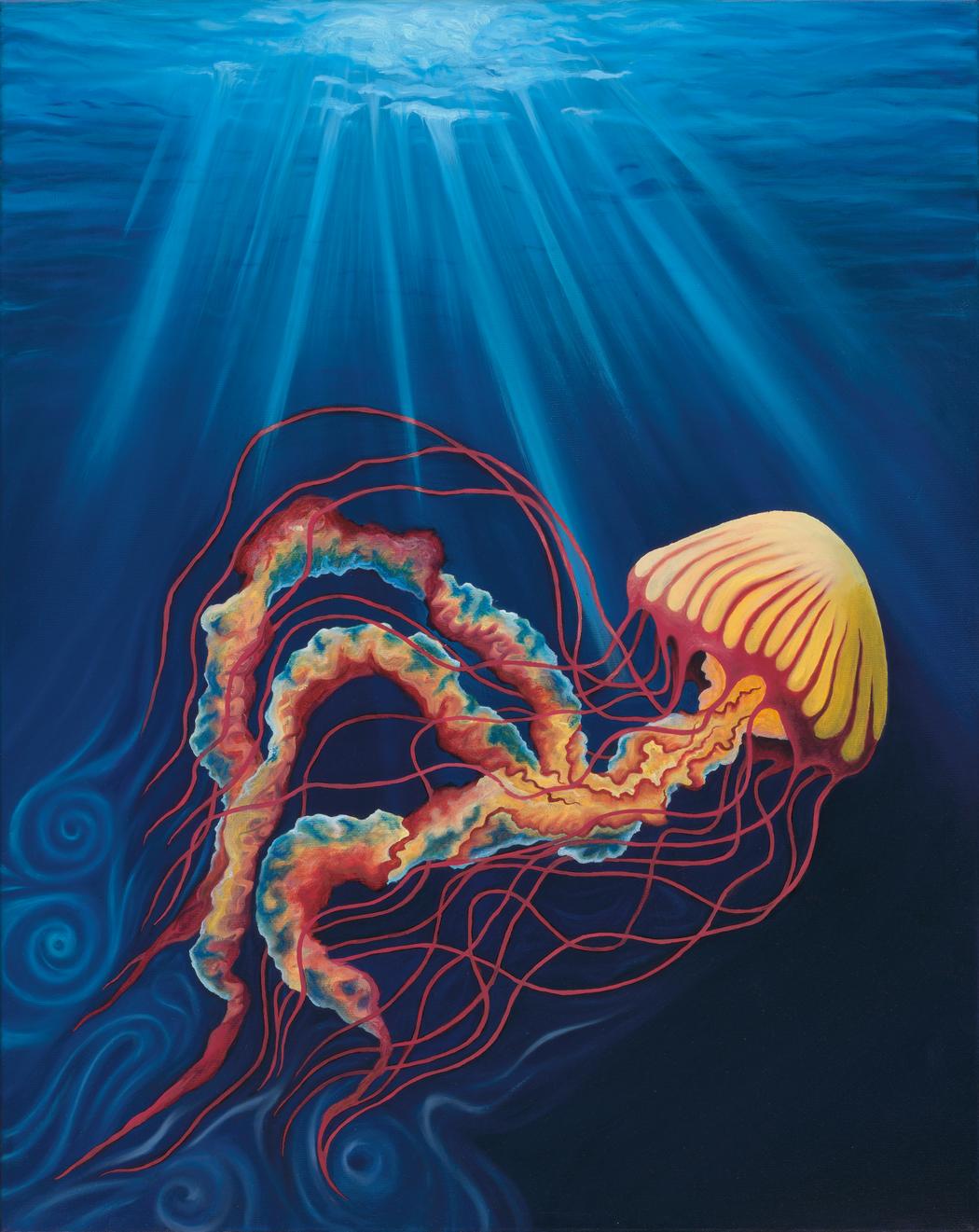 Miranda Moll | An Artist | 2025
Miranda Moll | An Artist | 2025
Many of your works blend emotion with scientific motifs. What inspires this intersection between science and feeling?
I am a deeply emotional person; this is something I have known about myself for most of my life. Everything I do in life is motivated by my emotional compass. My emotion comes through in my art, in my scientific endeavours, and in every aspect of my life. For me, the connection between science and feeling is not something I can turn off. The blending of emotion and scientific motifs happens organically and deeply.
I am also profoundly driven by my curiosity, both in my artistic and scientific worlds. I have this deep sense of wonder about the nature of existence, the origin of life, the experiences of other beings, and the collective human experience. In both fields, science and art, I am motivated by similar curiosities and questions. Science allows for the exploration of these questions in measurable, tangible ways, whereas art allows for the exploration of these questions in theoretical and unbound ways. When I paint or draw, I allow myself to explore that inner world of curiosity and awe, freely and intuitively.
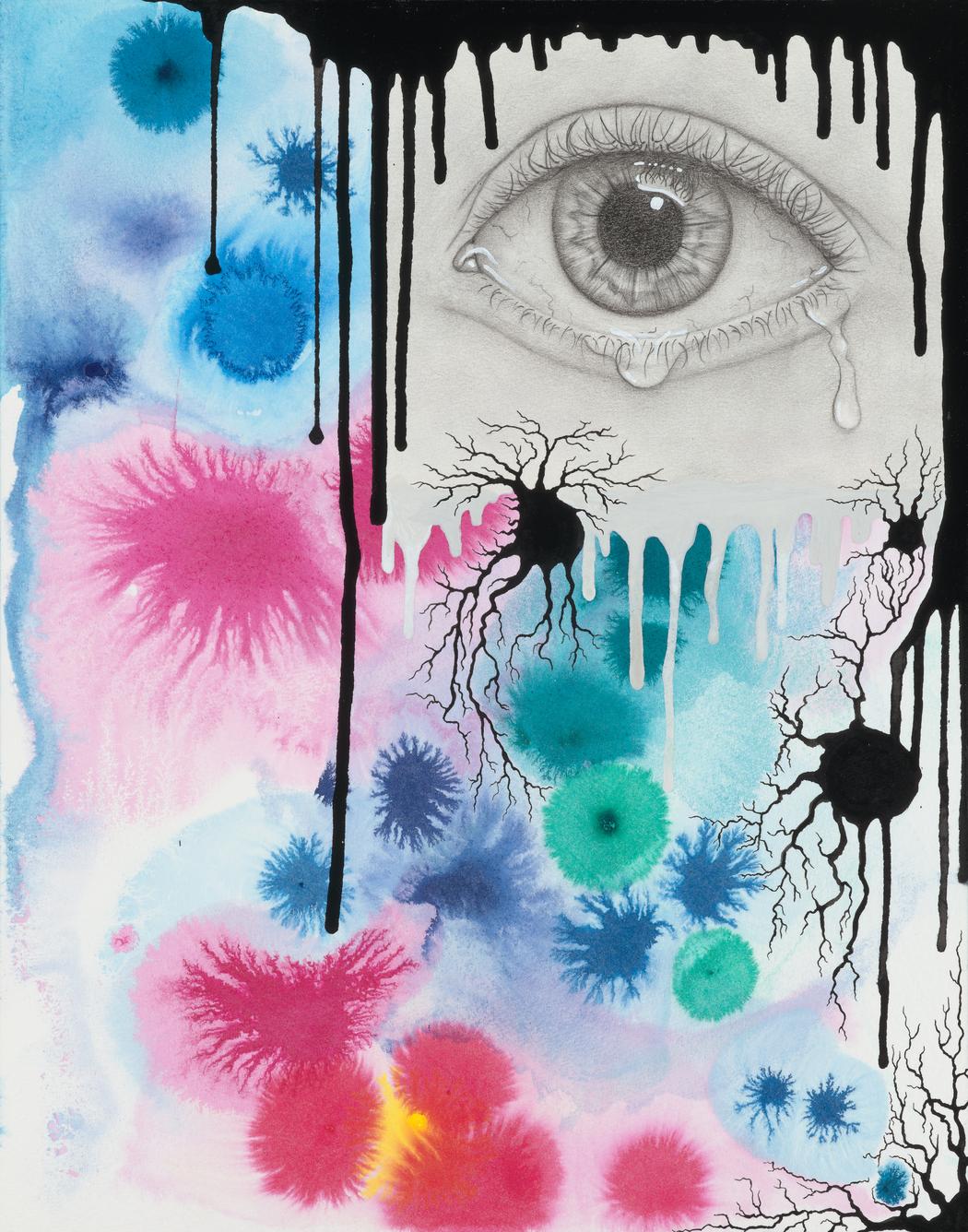 Miranda Moll | Melancholy | 2024
Miranda Moll | Melancholy | 2024
There’s a strong presence of eyes and vision in your work. What does the motif of the eye represent for you?
To me, eyes represent seeing and being seen. Perhaps even a sense of understanding or of being understood. They have a very fluid meaning, however, that can change depending on the context of the painting.
Because eyes can capture vivid emotional expression, I find them to be a powerful way to articulate concepts and feelings. Eyes are a huge part of facial expression, and we likely have genetic predispositions, influenced by social conditioning and development, that guide our understanding of emotional expression. As a social species, that skill is a necessary component of survival in a group environment. Over time, we have also developed cultural and religious symbols about eyes.
These preconceptions, coupled with the subconscious understanding of eyes and emotions, lead to a motif that can create a diversity of messages. It is a motif that is exciting to play with and explore.
How do your concerns about climate change and plastic pollution manifest in your art?
I am certainly someone who deals with climate anxiety. There is a lot of fear and sadness that manifests in my life, surrounding the state of our planet and the fate of our fellow species. I have been fortunate to see a lot of beautiful places and creatures on our planet, both within and outside of my home country. Watching that beauty and magnificence slip away, by our own doing, is hard to come to terms with.
Observing nature in its raw form or seeing a wild animal in its natural environment is pure magic. As a child, the wild places I experienced seemed untouched. And I grew up with this understanding that you enter nature with respect and you leave it in a state near to how you found it. Now, when I go out in ecosystems, I am bombarded by people’s carelessness. It seems like destruction is the norm. The unfortunate reality is that humans have disturbed the natural world, our world, irreparably.
Realistically, we are also contributing to our demise. It is something people do not often think about, but at the end of the day, the planet will re-equilibrate after this anthropogenic mass extinction. The question is, what species will still be here? And will humans be amongst those that make it?
All this manifests in my art in different ways. In some paintings, it is about capturing the beauty and wonders of the natural world. I want to showcase an entity, a species, a scene, through a perspective of wonder and admiration. When I am creating these paintings, I feel very free and awe-inspired. In other paintings, it is about recognizing the fragility and finiteness of life and existence, which tends to carry a sense of heaviness. Either perspective can shine through, depending on the piece I am creating and how I feel during the creation process.
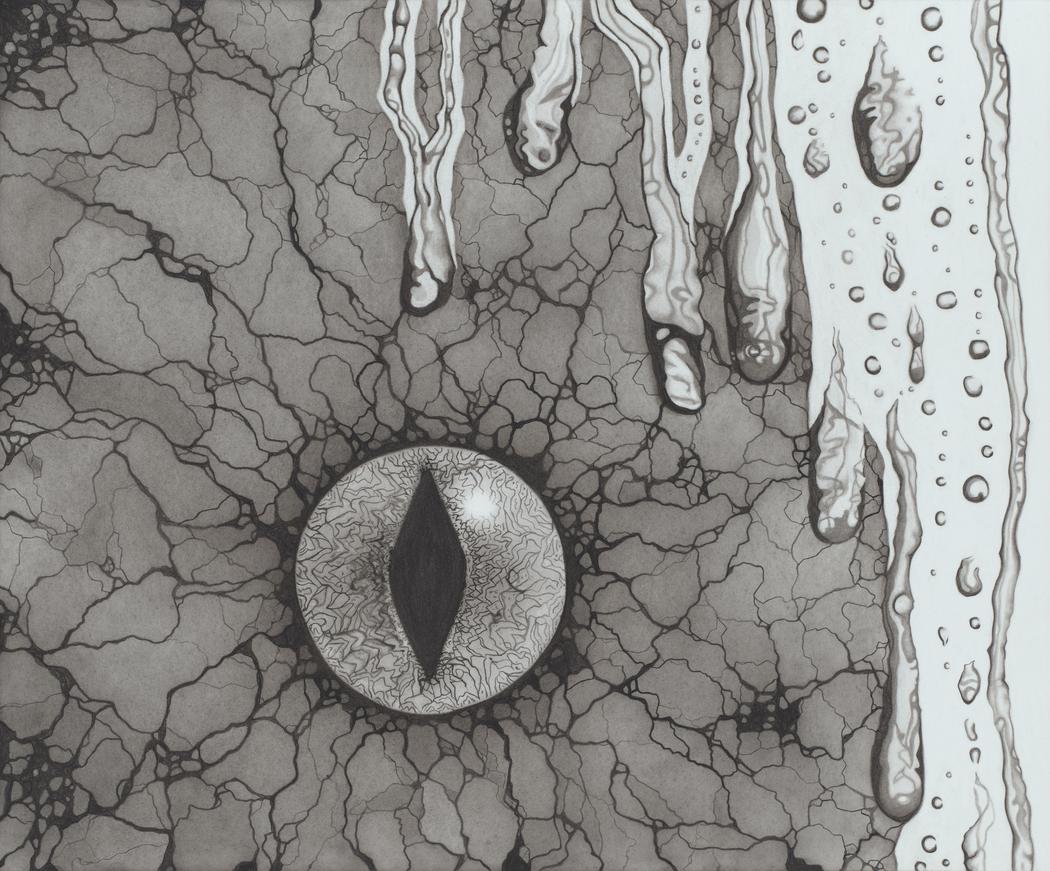 Miranda Moll | The Cleansing | 2024
Miranda Moll | The Cleansing | 2024
What is your creative process like? Do you start with a scientific idea, an emotion, or an image?
It changes quite a bit from painting to painting. Sometimes I start with a colour or pattern, and work to build my art piece on top of that feeling that has been created. Other times, I start with my subject, and I work to craft a narrative around that subject. And in other cases, I will start with a title and craft my painting around telling a story from that title. I do not have a set method; it changes quite a bit from painting to painting.
One thing that I am very deliberate about is never throwing a painting away. There are many times I start something and dislike it, for various reasons. When that happens, I put the painting to the side and wait until I feel ready or inspired to continue. I had an art teacher in high school who encouraged us to work this way, and I now feel it to be a foundational philosophy in my life.
Because of that mental and temporal separation from the onset of a piece to its completion, there is a lot of thought and emotion that goes into creating it. I often work on my paintings for months, sometimes over a year. I think it gives me time to build my piece and to tell a story.
Your color palette is striking—ranging from deep aquatic blues to vibrant cosmic tones. How do you choose your colors?
I love colour. There is so much vibrancy and life in our world; I enjoy capturing that essence in my paintings.
To create that, I like to work with a limited palette of transparent colours. I will work with two sets of each of the three primary colours, magenta/red, cyan/blue, and yellow, with those six colours, each tinted towards its neighbour on the colour wheel. With cyan/blue, for example, I work mostly with phthalo blue and ultramarine blue; phthalo blue is used alongside yellows, and ultramarine blue is used alongside magentas/reds. I try to reduce the mixing of all three primary colours as much as possible, which ultimately makes brown, to keep my paintings as vibrant as possible. I am also quite careful with white. I add it very deliberately to my transparent colours, because I have observed it changes the texture and depth quite dramatically. I will also mix my colour palette with each new painting. It keeps things interesting; there is always a new colour variation to explore and play with.
I have only been oil painting seriously since 2024, however, so I still have a lot to learn and explore.
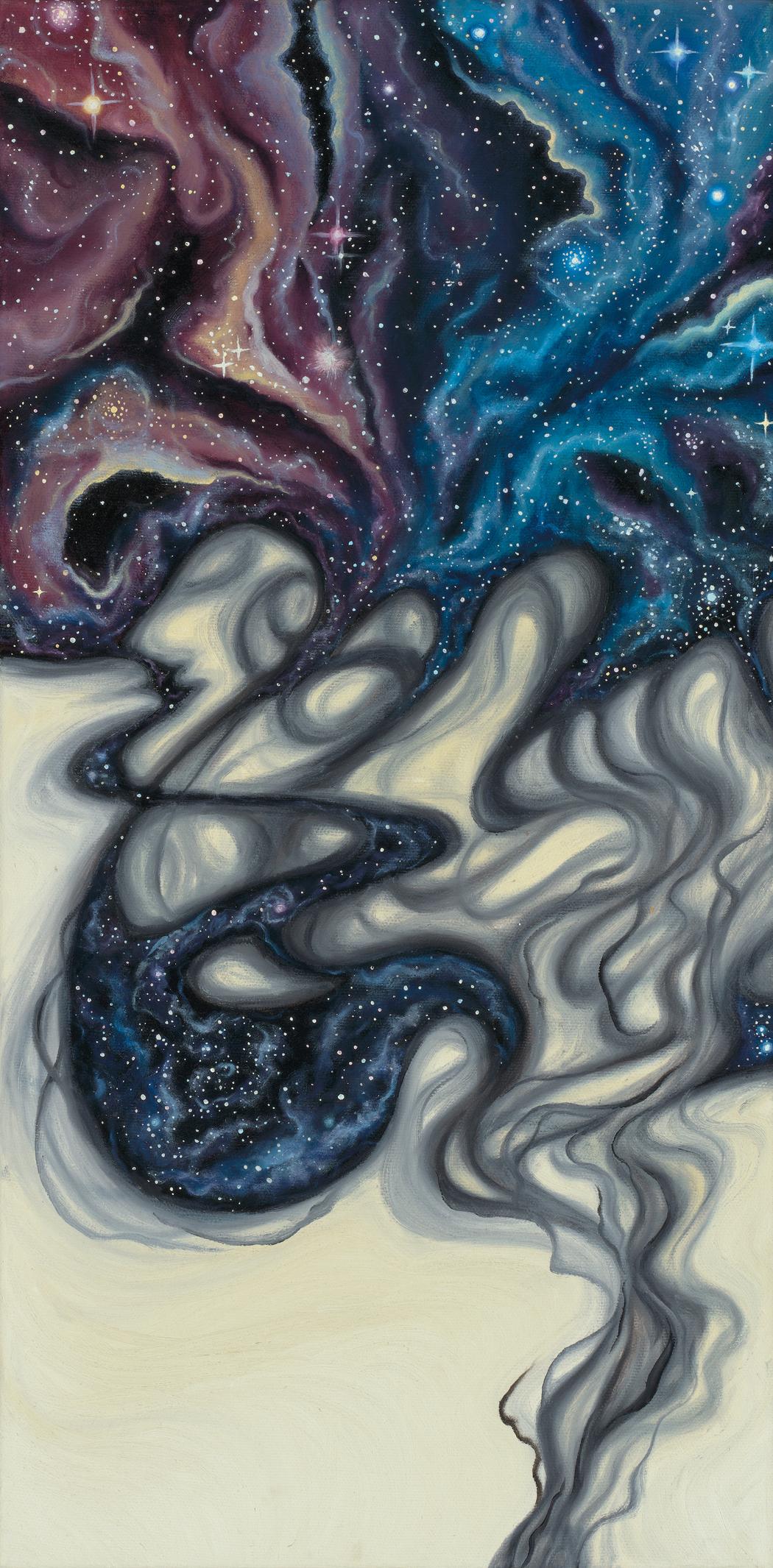 Miranda Moll | Spark Of Life | 2024
Miranda Moll | Spark Of Life | 2024
Do you see your art as a form of activism or scientific communication?
I have done a lot of work and volunteering in the science communication and environmental activism field. The biggest challenge I have found is that it is very hard to overcome people’s internal biases and narratives. Reciting facts to people has proven in my eyes to be an ineffective strategy in making societal change. There is quite a bit of psychology and social science that backs this up as well. People are more likely to become entrenched in their views when you tell them they are wrong or challenge their beliefs because it becomes a point of pride and self-protection.
I think the beauty of visual art is that it is silent. The observation and contemplation happen quietly, internally. There is something powerful in that. When you produce a visual art piece, you are not lecturing someone about a topic; you are providing an invitation to explore a concept from a different perspective. To that extent, I do consider my art to be a form of activism or scientific communication.

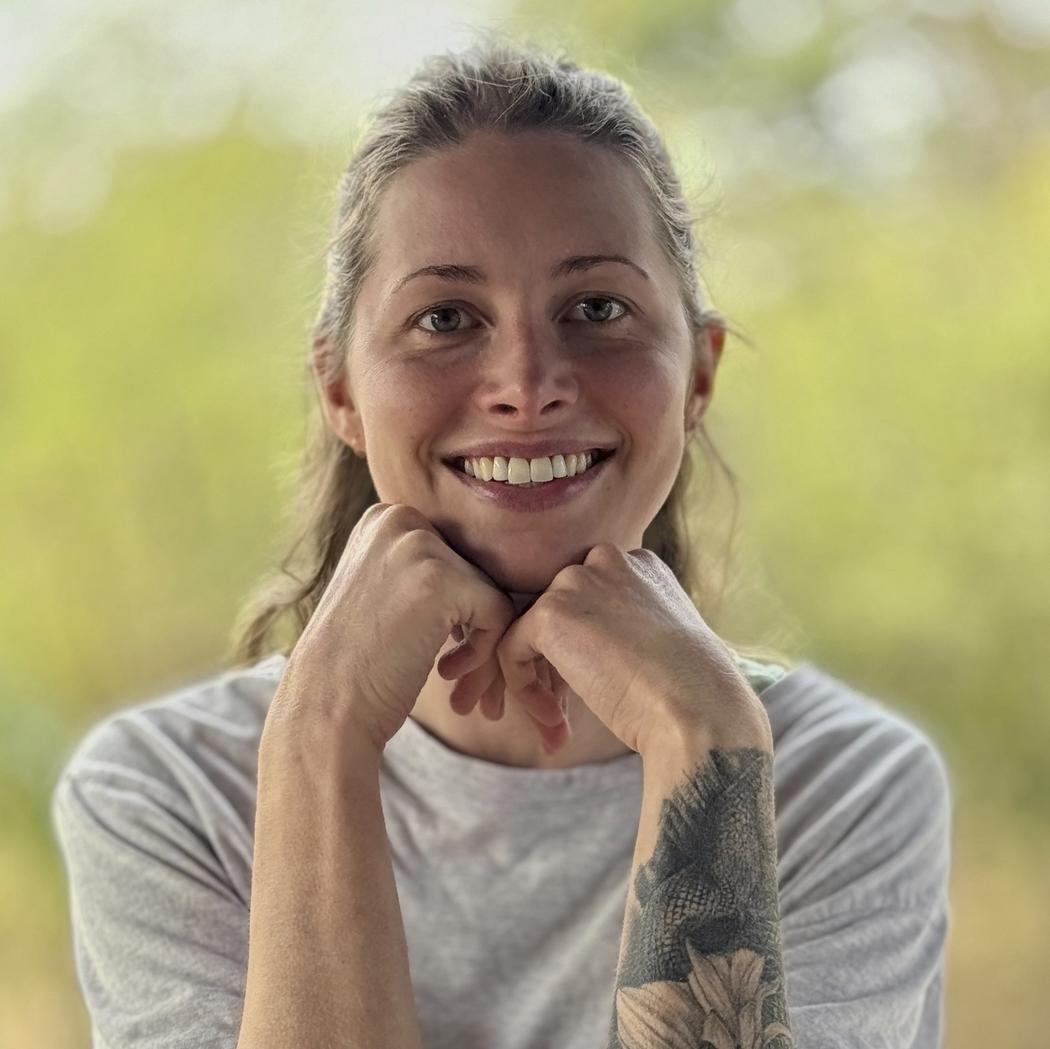
Leave a Reply